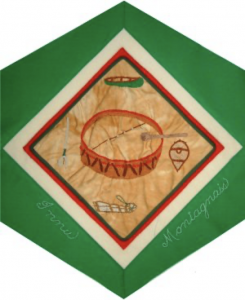Montagnais

The Block
Blockmaker Lise Mestokosho used traditional embroidery on caribou skin to express the history of the Montagais. The Teueikan, a sacred musical drum, was stitched in the center of the block. Played only by those men destined to do so, the Teueikan accompanies Innu songs that tell of their dreams, their hunts, their history, and thank the Great Spirit for future good hunting. The crumpled-leather background reflects the great master caribou Papakassik, who guides all natural and supernatural laws. The Innu tools of transportation and survival surround the sacred drum. Lise’s art illustrates how they travelled the lands and waterways, by canoe and on foot, by snowshoes and sled, harpooning salmon as a dietary staple.
Cultural Profile
The Montagnais, are an Innu people located in their traditional territory, referred to as Nitassinan, which stretches from the Laurentian Mountains to James Bay. They are the most populous Native nation in Quebec. French explorers called the Innu Montagnais, meaning “mountaineers.” They were also called the Kebic tribe, a possible source of the name Québec. The Innu language, Innu-aimun, is an Algonquin tongue similar to northern Cree. The Innu have used a strong oral tradition of stories, songs and dance to transmit legends from generation to generation.
As nomadic hunter-gatherers, they regularly packed up their birchbark wigwams and other belongings and moved to more favourable hunting grounds. In summer they gathered in villages near the rivers, and in winter they set up hunting camps in the interior. Deer, moose, seal and salmon were staples of the Innu diet, and porcupine meat was considered a delicacy. Following a successful hunt the Montagnais would celebrate with a feast called Mokushan. The accompanying drumming and songs were dedicated to the animal’s spirit. The Innu are a spiritual people, whose culture is focused on their relationship to the animals they hunt. To kill an animal is considered an act of respect as the animals have spiritual power, and allow themselves to be killed.
The Montagnais quickly established relations with Europeans based on the fur trade, abandoning a number of traditional practices to concentrate on trapping fur-bearing animals. By the mid-1900s the fur trade quickly began to decline and the Montagnais gradually began to settle in permanent villages, one of the last Canadian Aboriginal groups to do so. More recently the economic survival of many Innu is closely related to regaining rights to the salmon fishery. Over the course of the past century forestry and mining operations as well as hydro-electric projects have disrupted the traditional ways of life for the Montagnais.
Sponsor: Bernardine Greffe, in memoriam Celina & Cyprien Cousineau
